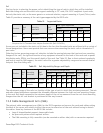
Dell
47
PowerEdge R515 Technical Guide
One key factor in selecting the proper rails is identifying the type of rack in which they will be installed.
Both the sliding rails and the static rails support mounting in 19‖-wide, EIA-310-E compliant 4-post racks,
but only the static rails, as the more generic or universal solution, support mounting in 2-post (Telco) racks.
Table 21 provides a summary of the rack types supported by the R515 rails.
Table 21. Supported Racks
Product
Rail
ID
Mounting
Interface
Rail
Type
Rack Types Supported
4-Post
2-Post
Square
Round
Thread
Flush
Center
R515
B3
ReadyRails
Sliding
√
√
√
*
X
X
B4
ReadyRails/Generic
Static
√
√
√
√
√
*Requires the 2U Threaded Rack Adapter Brackets Kit (Dell PN PKCR1)
Screws are not included in the static rail kit due to the fact that threaded racks are offered with a variety of
thread designations. Users must provide their own screws when mounting the static rails in threaded or 2-
post racks.
Other key factors governing proper rail selection include the spacing between the front and rear mounting
flanges of the rack, the type and location of any equipment mounted in the back of the rack such as power
distribution units (PDUs), and the overall depth of the rack. See Table 22. Due to their reduced complexity
and lack of need for CMA support, the static rails offer a greater adjustability range and an overall smaller
footprint than the sliding rails.
Table 22. Rail Adjustability Ranges and Depth
Product
Rail
ID
Mounting
Interface
Rail
Type
Rail Adjustability Range (mm)
Rail Depth (mm)
Square
Round
Threaded
without
CMA
with
CMA
Min
Max
Min
Max
Min
Max
R515
B3
ReadyRails
Sliding
686
883
672
876
651
897
714
845
B4
ReadyRails/
Generic
Static
608
879
594
872
604
890
622
N/A
The adjustment range of the rails is a function of the type of rack in which they are being mounted. The min
and max values listed above represent the allowable distance between the front and rear mounting flanges
in the rack. Rail depth represents the minimum depth of the rail as measured from the rack front mounting
flanges when the rail rear bracket is positioned all the way forward.
13.3 Cable Management Arm (CMA)
The optional cable management arm (CMA) for the R515 organizes and secures the cords and cables exiting
the back of the server and unfolds to allow the server to extend out of the rack without having to detach
the cables. Some key features of the R515 CMA include:
Large U-shaped baskets support dense cable loads.
An open-vent pattern allows optimal airflow.
The CMA mounting is fully-reversible (can be mounted on either side) with no conversion required.


















